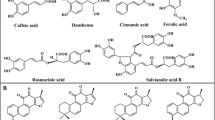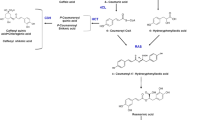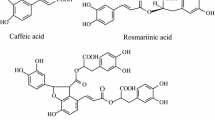Abstract
The purpose of this study is to reveal the impact of the plant hormone salicylic acid (SA) and methyl jasmonate (MeJA) on the growth, effective components accumulation, and related gene expression of the hairy root of Salvia przewalskii Maxim. Various concentrations of SA (0, 25, 50, 100, 200 μM) or MeJA (0, 50, 100, 200, 400, 600 μM) were added to the culture medium of Salvia przewalskii Maxim. Low concentrations of SA promoted the growth of hairy root, while a high concentration inhibited it. 0 to 400 μM MeJA promoted the growth of hairy root, but 600 μM MeJA starts to inhibit its growth. 50 μM SA and 400 μM MeJA significantly enhanced the production of caffeic acid, rosmarinic acid, salvianolic acid B, cryptotanshinone, and tanshinone IIA. In general, 50 μM SA can be used to accumulate of tanshinone in hairy roots of S. przewalskii with 6 days. 400 μM MeJA can be used to accumulate of phenolic acids in hairy roots of S. przewalskii with 3 days. The selected genes in the tanshinone and phenolic acid biosynthetic pathway were upregulated with elicitation. To obtain a higher yield and content of secondary metabolites, it is advisable to use 50 μM SA or 400 μM MeJA as the optimal doses to cultivate the hairy root of S. przewalskii. This study provides, for the first time, an efficient tanshinone and phenolic acid production method for S. przewalskii.










Similar content being viewed by others
Abbreviations
- SA:
-
Salicylic acid
- MeJA:
-
Methyl jasmonate
- FW:
-
Fresh weight
- DW:
-
Dry weight
- PAL :
-
Phenylalanine ammonia-lyase
- TAT :
-
Tyrosine aminotransferase
- HPPR :
-
4-Hydroxyphenylpyruvate reductase
- 4CL1 :
-
4-Coumaric acid CoA-ligase 1
- RAS :
-
Rosmarinic acid synthase
- CYP98A14 :
-
Acytochrome P450-dependent monooxygenase
- HMGR :
-
3-Hydroxy-3-methylglutaryl CoA reductase
- DXR :
-
1-Deoxy-d-xylulose 5-phosphate reductoisomerase
- DXS :
-
1-Deoxy-d-xylulose 5-phosphate synthase
- IPPI :
-
Isopentenyl-diphosphate delta-isomerase
- GGPPS :
-
Geranylgeranyl diphosphate synthase
- CPS :
-
Copalyl diphosphate synthase
- KSL :
-
Entkaurene synthase like
- qRT-PCR:
-
Real-time quantitative PCR
References
Ewa S, Halina W (2005) Tanshinone production in roots of micropropagated Salvia przewalskiiMaxim. Z Naturfr C 60:7–8
Li X, Luo Y, Wang L et al (2010) Acute and subacute toxicity of ethanol extracts from Salvia przewalskii Maxim in rodents. J Ethnopharmacol 131(1):110–115
Liu J, Nan P, Tsering Q et al (2010) Volatile constituents of the leaves and flowers of Salvia przewalskii Maxim. from Tibet. Flavour Fragr J 21(3):435–438
Wang L, Jiang YY, Zhang L et al (2017) High-performance liquid chromatography fingerprints and simultaneous quantification of bioactive compounds in Salvia przewalskii maxim. Acta Chromatogr 29(3):1–18
Matkowski A, Zielińska S, Oszmiański J et al (2008) Antioxidant activity of extracts from leaves and roots of Salvia miltiorrhiza Bunge, S. przewalskii Maxim. and S. verticillata L. Bioresour Technol 99(16):7892–7896
Jassbi AR, Zare S, Firuzi O et al (2016) Bioactive phytochemicals from shoots and roots of Salvia species. Phytochem Rev 15(5):829–867
Gryszczynska A, Opala B, Lowicki Z et al (2015) Bioactive compounds determination in the callus and hydroalcoholic extracts from Salvia miltiorrhiza and Salvia przewalskii—preliminary study on their anti-alcoholic activity effects. Phytochem Lett 11:399–403
Yang D, Huang Z, Xing B et al (2016) Regulation of folic acid on phenolic acids production in Salvia miltiorrhizahairy roots. Plant Cell Tissue Organ Cult 127(1):175–185
Wang M, Dai H, Li X et al (2010) Structural elucidation of metabolites of tanshinone I and its analogue dihydrotanshinone I in rats by HPLC-ESI-MSn. J Chromatogr B 878(13–14):915–924
Petersen M, Abdullah Y, Benner J et al (2009) Evolution of rosmarinic acid biosynthesis. Phytochemistry 70(15–16):1663–1679
Wu J, Shi M (2008) Ultrahigh diterpenoid tanshinone production through repeated osmotic stress and elicitor stimulation in fed-batch culture of Salvia miltiorrhiza hairy roots. Appl Microbiol Biotechnol 78(3):441–448
Gülçin I (2006) Antioxidant activity of caffeic acid (3, 4-dihydroxycinnamic acid). Toxicology 217(2):213–220
Yang L, Li X, Liu C et al (2011) Chemical constituents from Salvia przewalskii Maxim. Acta Pharm Sin 46(7):818–821
Xue M, Shi Y, Cui Y et al (2000) Study on the chemical constituents from Salvia przewalskii Maxim. Tianran Chanwu Yanjiu Yu Kaifa 12:27–32
Wan C, Ming JX, Dong ZW et al (2003) Chemical constituents in the roots of Salvia przewalskii Maxim. Acta Pharm Sin 38(5):354
Liao P, Zhou W, Zhang L et al (2009) Molecular cloning, characterization and expression analysis of a new gene encoding 3-hydroxy-3-methylglutaryl coenzyme A reductase from Salvia miltiorrhiza. Acta Physiol Plant 31(3):565–572
Park EJ, Zhao YZ, Kim YC et al (2009) Preventive effects of a purified extract isolated from Salvia miltiorrhiza enriched with tanshinone I, tanshinone IIA and cryptotanshinone on hepatocyte injury in vitro and in vivo. Food Chem Toxicol 47:2742–2748
Ling S, Dai A, Guo Z et al (2010) Effects of a chinese herbal preparation on vascular cells in culture: mechanisms of cardiovascular protection. Clin Exp Pharmacol Physiol 32(7):571–578
SkaŁA E, Mielicki W, Halina W (2014) Tanshinones in culture of salvia przewalskii maxim in vitro. Acta Biol Crac Ser Bot 56(1):104–110
Chen H, Yuan JP, Chen F et al (1997) Tanshinone production in Ti-transformed Salvia miltiorrhiza cell suspension cultures. J Biotechnol 58(3):147–156
Dweck AC (2000) The folklore and cosmetic use of various Salvia species. Harwood Academic Publishers, Reading, pp 1–25
Hu ZD, Jia L, Zhang ZP et al (1997) Studies of Crude ethanol extract of roots of Salvia przewalskii maxim by micellar electrokinetic capillary chromatography. J Liq Chromatogr Relat Technol 20(8):1211–1220
Wang Z, Cui L, Chen C et al (2012) Down regulation of cinnamoyl CoA teductase affects lignin and phenolic acids biosynthesis in Salvia miltiorrhiza Bunge. Plant Mol Biol Rep 30(5):1229–1236
Zhang S, Yan Y, Wang B et al (2014) Selective responses of enzymes in the two parallel pathways of rosmarinic acid biosynthetic pathway to elicitors in Salvia miltiorrhiza hairy root cultures. J Biosci Bioeng 117(5):645–651
Laule O, Fürholz A, Chang HS et al (2003) Crosstalk between cytosolic and plastidial pathways of isoprenoid biosynthesis in Arabidopsis thaliana. Proc Natl Acad Sci 100(11):6866–6871
Yan X, Zhang L, Wang J et al (2019) Molecular characterization and expression of 1-deoxy-d-xylulose 5-phosphate reductoisomerase (DXR) gene from Salvia miltiorrhiza. Acta Physiol Plant 31:1015–1022
Kai G, Liao P, Zhang T et al (2010) Characterization, expression profiling, and functional identification of a gene encoding geranylgeranyl diphosphate synthase from Salvia miltiorrhiza. Biotechnol Bioprocess Eng 15(2):236–245
Ma P, Liu J, Osbourn A et al (2015) Regulation and metabolic engineering of tanshinone biosynthesis. RSC Adv 5(23):18137–18144
Zhao J, Zhou L, Wu J (2010) Effects of biotic and abiotic elicitors on cell growth and tanshinone accumulation in Salvia miltiorrhiza cell cultures. Appl Microbiol Biotechnol 87(1):137–144
Xiao Y, Gao S, Di P et al (2009) Methyl jasmonate dramatically enhances the accumulation of phenolic acids in Salvia miltiorrhiza hairy root cultures. Physiol Plant 137(1):1–9
El JN, Barres ML, Ravelo ÁG et al (2008) Effects of elicitors on tropane alkaloids and gene expression in Atropa baetica transgenic hairy roots. J Nat Prod 71(12):2026–2031
Dong J, Wan G, Liang Z (2010) Accumulation of salicylic acidinduced phenolic compounds and raised activities of secondary metabolic and antioxidative enzymes in Salvia miltiorrhiza cell culture. J Biotechnol 148(2–3):99–104
Mizukami H, Tabira Y, Ellis BE (1993) Methyl jasmonate-induced rosmarinic acid biosynthesis in Lithospermum erythrorhizon cell suspension cultures. Plant Cell Rep 12(12):706–709
Li B, Wang B, Li H et al (2016) Establishment of Salvia castanea Diels f. tomentosa Stib. hairy root cultures and the promotion of tanshinone accumulation and gene expression with Ag(+), methyl jasmonate, and yeast extract elicitation. Protoplasma 253(1):87–100
Ru M, An Y, Wang K et al (2016) Prunella vulgaris L. hairy roots: culture, growth, and elicitation by ethephon and salicylic acid. Eng Life Sci 6:494–502
Xing B, Yang D, Guo W et al (2014) Ag+ as a more effective elicitor for production of tanshinones than phenolic acids in Salvia miltiorrhiza hairy roots. Molecules 20(1):309–324
Porebski S, Bailey LG, Baum BR (1997) Modification of a CTAB DNA extraction protocol for plants containing high polysaccharide and polyphenol components. Plant Mol Biol Rep 15:8–15
Królicka A, Staniszewska I, Bielawski K et al (2001) Establishment of hairy root cultures of Ammi majus. Plant Sci 160:259–264
Giri A, Narasu ML (2000) Transgenic hairy roots. Recent trends and applications. Biotechnol Adv 18(1):1–22
Liu J, Li Y, Chen W et al (2010) Transgenic plant hairy root: future and application. Acad J Second Mil Med Univ 30(4):433–437
Condori J, Sivakumar G, Hubstenberger J et al (2010) Induced biosynthesis of resveratrol and the prenylated stilbenoids arachidin-1 and arachidin-3 in hairy root cultures of peanut: Effects of culture medium and growth stage. Plant Physiol Biochem 48(5):310–318
Rodriguez S, Compagnon V, Crouch NP et al (2003) Jasmonate-induced epoxidation of tabersonine by a cytochrome P-450 in hairy root cultures of Catharanthus roseus. Phytochemistry 64(2):401–409
Banerjee S, Rahman L, Uniyal GC et al (1998) Enhanced production of valepotriates by Agrobacterium rhizogenes induced hairy root cultures of Valeriana wallichii DC. Plant Sci 131(2):203–208
Fukami H, Asakura T, Hirano H et al (2002) Salicylic acid carboxyl methyltransferase induced in hairy root cultures of atropa belladonna after treatment with exogeneously added salicylic acid. Plant Cell Physiol 43(9):1054
Kai G, Liao P, Xu H et al (2012) Molecular mechanism of elicitor-induced tanshinone accumulation in Salvia miltiorrhizahairy root cultures. Acta Physiol Plant 34(4):1421–1433
Yang J, Wang K, Liang J et al (2016) Effects of exogenous MeJA, SA and two kinds of endophytic fungi on physiology and total phenols content of seedlings of Bletilla striata. China J Chin Materia Med 41(15):2794
Danaee M, Farzinebrahimi R, Kadir AF et al (2015) Effects of MeJA and SA elicitation on secondary metabolic activity, antioxidant content and callogenesis in Phyllanthus pulcher. Braz J Bot 38(2):265–272
Khalili M, Hasanloo T, Kazemi Tabar SK et al (2009) Influence of exogenous salicylic acid on flavonolignans and lipoxygenase activity in the hairy root cultures of Silybum marianum. Cell Biol Int 33(9):988–994
Sivanandhan G, Dev GK, Jeyaraj M et al (2013) Increased production of withanolide A, withanone, and withaferin A in hairy root cultures of Withania somnifera (L.) Dunal elicited with methyl jasmonate and salicylic acid. Plant Cell Tissue Organ Cult 114(1):121–129
Jiao J, Gai Q, Wang W et al (2016) Enhanced astragaloside production and transcriptional responses of biosynthetic genes in Astragalus membranaceus hairy root cultures by elicitation with methyl jasmonate. Biochem Eng J 105:339–346
Perassolo M, Cardillo AB, Mugas ML et al (2017) Enhancement of anthraquinone production and release by combination of culture medium selection and methyl jasmonate elicitation in hairy root cultures of Rubia tinctorum. Ind Crops Prod 105:124–132
Yu H, Liu X, Gao S et al (2014) Molecular cloning and functional characterization of a phenylalanine ammonia-lyase from liverwort Plagiochasma appendiculatum. Plant Cell Tissue Organ Cult 117(2):265–277
Acknowledgements
This work was supported by: (1) Subject Innovation Team of Quality Control and Resources Development of “Qin drug” of Shaanxi University of Chinese Medicine (2019-QN01). (2) Subject of Standardization construction of the Tussilago farfara L.(202410001). (3) Subject of Study on Breeding of Excellent Varieties and Quality Control Techniques of Polygala tenuifolia Willd (201330001). (4) Special Project for Construction of Modern Agricultural Industrial Technology System (CARS-21). (5) Scientific Research Project of Education Department of Shaanxi Provincial Government (18JK0214).
Author information
Authors and Affiliations
Corresponding authors
Ethics declarations
Conflict of interest
The authors declare no conflict of interest.
Ethical approval
This article does not contain any studies with human participants or animals performed by any of the authors.
Additional information
Publisher's Note
Springer Nature remains neutral with regard to jurisdictional claims in published maps and institutional affiliations.
Rights and permissions
About this article
Cite this article
Li, J., Li, B., Luo, L. et al. Increased phenolic acid and tanshinone production and transcriptional responses of biosynthetic genes in hairy root cultures of Salvia przewalskii Maxim. treated with methyl jasmonate and salicylic acid. Mol Biol Rep 47, 8565–8578 (2020). https://doi.org/10.1007/s11033-020-05899-1
Received:
Accepted:
Published:
Issue Date:
DOI: https://doi.org/10.1007/s11033-020-05899-1




